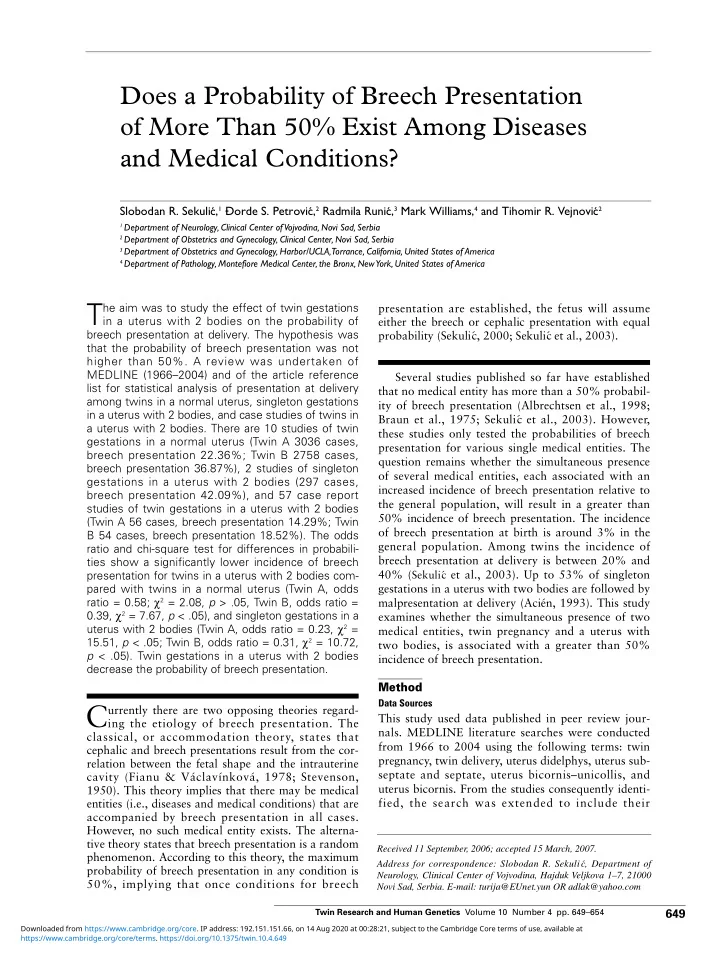

Does a Probability of Breech Presentation of More Than 50% Exist Among Diseases and Medical Conditions? c, 1 - c, 2 Radmila Runi´ c, 3 Mark Williams, 4 and Tihomir R. Vejnovi´ Slobodan R. Sekuli´ Dorde S. Petrovi´ c 2 1 Department of Neurology, Clinical Center of Vojvodina, Novi Sad, Serbia 2 Department of Obstetrics and Gynecology, Clinical Center, Novi Sad, Serbia 3 Department of Obstetrics and Gynecology, Harbor/UCLA,Torrance, California, United States of America 4 Department of Pathology, Montefiore Medical Center, the Bronx, New York, United States of America T he aim was to study the effect of twin gestations presentation are established, the fetus will assume in a uterus with 2 bodies on the probability of either the breech or cephalic presentation with equal breech presentation at delivery. The hypothesis was probability (Sekuli´ c, 2000; Sekuli´ c et al., 2003). that the probability of breech presentation was not higher than 50%. A review was undertaken of MEDLINE (1966–2004) and of the article reference Several studies published so far have established list for statistical analysis of presentation at delivery that no medical entity has more than a 50% probabil- among twins in a normal uterus, singleton gestations ity of breech presentation (Albrechtsen et al., 1998; in a uterus with 2 bodies, and case studies of twins in Braun et al., 1975; Sekuli´ c et al., 2003). However, a uterus with 2 bodies. There are 10 studies of twin these studies only tested the probabilities of breech gestations in a normal uterus (Twin A 3036 cases, presentation for various single medical entities. The breech presentation 22.36%; Twin B 2758 cases, question remains whether the simultaneous presence breech presentation 36.87%), 2 studies of singleton of several medical entities, each associated with an gestations in a uterus with 2 bodies (297 cases, increased incidence of breech presentation relative to breech presentation 42.09%), and 57 case report the general population, will result in a greater than studies of twin gestations in a uterus with 2 bodies 50% incidence of breech presentation. The incidence (Twin A 56 cases, breech presentation 14.29%; Twin of breech presentation at birth is around 3% in the B 54 cases, breech presentation 18.52%). The odds general population. Among twins the incidence of ratio and chi-square test for differences in probabili- breech presentation at delivery is between 20% and ties show a significantly lower incidence of breech 40% ( Sekuli´ c et al., 2003). Up to 53% of singleton presentation for twins in a uterus with 2 bodies com- gestations in a uterus with two bodies are followed by pared with twins in a normal uterus (Twin A, odds ratio = 0.58; χ 2 = 2.08, p > .05, Twin B, odds ratio = malpresentation at delivery (Acién, 1993). This study 0.39, χ 2 = 7.67, p < .05), and singleton gestations in a examines whether the simultaneous presence of two uterus with 2 bodies (Twin A, odds ratio = 0.23, χ 2 = medical entities, twin pregnancy and a uterus with 15.51, p < .05; Twin B, odds ratio = 0.31, χ 2 = 10.72, two bodies, is associated with a greater than 50% p < .05). Twin gestations in a uterus with 2 bodies incidence of breech presentation. decrease the probability of breech presentation. Method Data Sources C urrently there are two opposing theories regard- This study used data published in peer review jour- ing the etiology of breech presentation. The nals. MEDLINE literature searches were conducted classical, or accommodation theory, states that from 1966 to 2004 using the following terms: twin cephalic and breech presentations result from the cor- pregnancy, twin delivery, uterus didelphys, uterus sub- relation between the fetal shape and the intrauterine septate and septate, uterus bicornis–unicollis, and cavity (Fianu & Václavínková, 1978; Stevenson, uterus bicornis. From the studies consequently identi- 1950). This theory implies that there may be medical fied, the search was extended to include their entities (i.e., diseases and medical conditions) that are accompanied by breech presentation in all cases. However, no such medical entity exists. The alterna- tive theory states that breech presentation is a random Received 11 September, 2006; accepted 15 March, 2007. phenomenon. According to this theory, the maximum Address for correspondence: Slobodan R. Sekuli´ c, Department of probability of breech presentation in any condition is Neurology, Clinical Center of Vojvodina, Hajduk Veljkova 1–7, 21000 50%, implying that once conditions for breech Novi Sad, Serbia. E-mail: turija@EUnet.yun OR adlak@yahoo.com Twin Research and Human Genetics Volume 10 Number 4 pp. 649–654 649 Downloaded from https://www.cambridge.org/core. IP address: 192.151.151.66, on 14 Aug 2020 at 00:28:21, subject to the Cambridge Core terms of use, available at https://www.cambridge.org/core/terms. https://doi.org/10.1375/twin.10.4.649
Recommend
More recommend